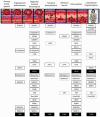Metastasis suppressors in breast cancers: mechanistic insights and clinical potential
- PMID: 24311119
- PMCID: PMC3923422
- DOI: 10.1007/s00109-013-1109-y
Metastasis suppressors in breast cancers: mechanistic insights and clinical potential
Abstract
For the most part, normal epithelial cells do not disseminate to other parts of the body and proliferate, as do metastatic cells. Presumably, a class of molecules-termed metastasis suppressors-are involved in this homeostatic control. Metastasis suppressors are, by definition, cellular factors that, when re-expressed in metastatic cells, functionally inhibit metastasis without significantly inhibiting tumor growth. In this brief review, we catalog known metastasis suppressors, what is known about their mechanism(s) of action, and experimental and clinical associations to date.
Figures

Similar articles
-
Recent advances in breast cancer metastasis suppressor 1.Int J Biol Markers. 2011 Jan-Mar;26(1):1-8. doi: 10.5301/jbm.2011.6267. Int J Biol Markers. 2011. PMID: 21279956 Review.
-
Metastasis suppressors and their roles in breast carcinoma.J Mammary Gland Biol Neoplasia. 2007 Sep;12(2-3):175-90. doi: 10.1007/s10911-007-9049-1. J Mammary Gland Biol Neoplasia. 2007. PMID: 17587154 Free PMC article. Review.
-
Metastasis suppressors genes in cancer.Int J Biochem Cell Biol. 2008;40(5):874-91. doi: 10.1016/j.biocel.2007.12.016. Epub 2008 Jan 15. Int J Biochem Cell Biol. 2008. PMID: 18280770 Review.
-
Follistatin is a metastasis suppressor in a mouse model of HER2-positive breast cancer.Breast Cancer Res. 2017 Jun 5;19(1):66. doi: 10.1186/s13058-017-0857-y. Breast Cancer Res. 2017. PMID: 28583174 Free PMC article.
-
TRIMming down tumor suppressors in breast cancer.Cell Cycle. 2015;14(9):1345-6. doi: 10.1080/15384101.2015.1024584. Cell Cycle. 2015. PMID: 25790001 Free PMC article. No abstract available.
Cited by
-
Anti-tumor peptide SA12 inhibits metastasis of MDA-MB-231 and MCF-7 breast cancer cells via increasing expression of the tumor metastasis suppressor genes, CDH1, nm23-H1 and BRMS1.Exp Ther Med. 2020 Aug;20(2):1758-1763. doi: 10.3892/etm.2020.8886. Epub 2020 Jun 12. Exp Ther Med. 2020. PMID: 32742405 Free PMC article.
-
Is There One Key Step in the Metastatic Cascade?Cancers (Basel). 2021 Jul 22;13(15):3693. doi: 10.3390/cancers13153693. Cancers (Basel). 2021. PMID: 34359593 Free PMC article.
-
Expression and clinical significance of YAP in laryngeal squamous cell carcinoma patients.Oncol Lett. 2017 Mar;13(3):1311-1314. doi: 10.3892/ol.2016.5541. Epub 2016 Dec 27. Oncol Lett. 2017. PMID: 28454253 Free PMC article.
-
Regulation of breast cancer metastasis signaling by miRNAs.Cancer Metastasis Rev. 2020 Sep;39(3):837-886. doi: 10.1007/s10555-020-09905-7. Cancer Metastasis Rev. 2020. PMID: 32577859 Free PMC article. Review.
-
MicroRNA-205 promotes cell invasion by repressing TCF21 in human ovarian cancer.J Ovarian Res. 2017 May 5;10(1):33. doi: 10.1186/s13048-017-0328-1. J Ovarian Res. 2017. PMID: 28476165 Free PMC article.
References
-
- Steeg PS. Tumor metastasis: mechanistic insights and clinical challenges. Nat Med. 2006;12:895–904. DOI 10.1038/nm1469. - PubMed
-
- Steeg PS, Bevilacqua G, Pozzatti R, Liotta LA, Sobel ME. Altered expression of NM23, a gene associated with low tumor metastatic potential, during adenovirus 2 Ela inhibition of experimental metastasis. Cancer Res. 1988;48:6550–6554. - PubMed
Publication types
MeSH terms
Substances
Grants and funding
LinkOut - more resources
Full Text Sources
Other Literature Sources
Medical

